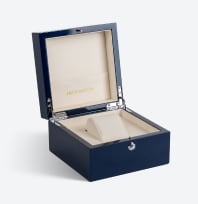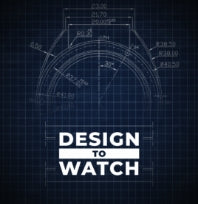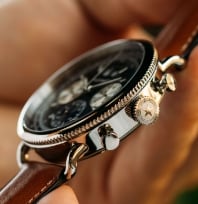The origin of clocks and watches, as we recognize them today, first emerged in the late 15th century. However, measuring time has always been important. The previously-mentioned date only accounts for the last 600 years of history, which begs the question: How did people tell time before clocks?
First, to clear a misconception: All timepieces listed below can be considered clocks, as they all share two common factors with modern clocks.
- They use a constant motion to mark off units of time.
- They feature a means of tracking said motion and displaying the time.
We will be covering the history of timekeeping up to the invention of a portable mechanical clock with a dial able to display hours, minutes, and seconds.
Sundials
The earliest known timekeeping devices appeared in Egypt and Mesopotamia, around 3500 BCE. Sundials consisted of a tall vertical or diagonal-standing object used to measure the time, called a gnomon. Sundials were able to measure time (with relative accuracy) by the shadow caused by the gnomon.
The earliest wholly verified appearance of a sundial is the Egyptian shadow clock, circa 1500 BCE. This clock used the passage of the sun overhead to help people decipher the time. It featured a crosspiece placed to the east of the gnomon, with markings set to delineate the hours.
Noon occurred at midday, and it would be at this time that the crosspiece would be moved to the west of the gnomon. The days would be divided into 12 hours (which we will discuss later).
At night, a tool called a merkhet would be used. The merkhet consisted of two bars placed in alignment with the pole star. It used the pole star's position to track the relative movement of the stars and constellations.
Naturally, sundials had some flaws in their construction. However, we can view mankind’s ability to start documenting parts of the day with a timepiece as a massive technological leap. The most glaring fault is that of accuracy:
The length of daylight hours varies throughout the seasons, and for this reason, the measurement and value of an hourly “unit” varies as well. Furthermore, daylight hours vary based on region, location, and even city.
Because of this, universal time did not exist and would not for millennia later. The varying hours were called “seasonal hours.” They would be used by the Greeks and the Romans, who would spread the timekeeping method across the world.
The use of the astrological clock in tandem with shadow clocks allowed the development of Egypt’s year. This calendar consisted of 12 30-day periods based on the lunar cycle, followed by a 5-day period to accurately represent the yearly changing seasons.
In Egypt and other countries closer to the equator, the lunar cycle is more essential to timekeeping than the solar cycle because of their temperate climates. For them, the passage of the moon is more perceptible than the changing of the seasons.
Improvements on the Sundial
Later groups would improve upon the concept of shadow clocks, in particular the Greeks and
Romans. One version of the sundial features an obelisk in the center of a hemispherical bowl, with markings delineating days, months, and seasons.
Records of a supposedly universal sundial exist from the 1st century BCE, but the design of the sundial itself has not survived. Soon, however, a true universal sundial would appear.
The greatest improvement upon the sundial came in 1371. The most accurate sundial times occur where the trajectory of the sun is most constant: Along Earth’s axis and around the equator.
Ibn al-Shatir proved that placing the gnomon of a sundial parallel to Earth’s axis creates shadows with equal hours each day of the year. This discovery soon became common practice in construction and created the iconic “diagonal” appearance of modern sundials.
Water Clocks
The next clock mentioned has the distinguishing mark of being both the first-timer as well as the first clock verifiably used in a court of law. “Water clock” refers to a large number of clocks using water as a measuring device. There are two general types of water clocks: Intake and outtake.
- Intake water clocks feature a central device that slowly takes on water from a basin or other reservoir it is placed in.
- Outtake water clocks feature water slowly draining from an object, either directly into a reservoir or into a water wheel where the water powers the movement of the clock.
Either way, water clocks have the benefit of being usable both at night and on cloudy days, as well as being able to more closely measure actual hours, as opposed to seasonal hours.
In historical context, water clocks were used judicially when measuring the length of time one was allowed to speak, as well as to measure time at night. The measurement markings would be read based on the water level.
Regardless of their conceptual strength, water clocks still had their flaws:
For one, freezing weather rendered water clocks useless. Secondly, water pressure was variable. Unfortunately, as the water levels in outtake machines dropped, so did the rate at which water flowed from the machine. Still, water clocks remained a useful and popular horological tool well into the advent of the mechanical clock.
Hourglasses
When discussing pre-modern timepieces, the hourglass may be the one to most immediately come to mind. However, hourglasses are fairly new compared to the other timepieces on this list, having only appeared in records starting in the 1300s.
Hourglasses were not designed to create a new level of accuracy but served a far more practical purpose:
They could reliably separate periods of time. They were also cheaper and simpler to maintain than a sundial, water clock, or, later on, mechanical clock. For this reason, hourglasses were especially popular on naval vessels.
On boats, hourglasses remained dry and steady; they would be unaffected by the rocking of the ship and inclement weather. These factors would normally alter the efficacy of other timekeeping methods. With the rise of the mechanical clock, hourglasses soon fell out of favor as other, more precise methods came into vogue.
However, the hourglass as a symbol of time and mortality endures, no doubt due to the image of sand slowly running out.
The Church Belltowers
The first mechanical clocks appeared in 1283 in Bedfordshire, England. These clocks were designed for the Roman Catholic Church, which had both the financial sway to undertake such projects, as well as the need for precise temporal measurements for prayer.
The clocks were weight-driven, and because these early examples often sounded out the time by the clanging of bells, the word “Clock” was adopted from the french clocca, meaning bell.
Neither the weight of the machine nor the gear wheels were new. However, the escapement, which controlled the motion of the gears and transmitted that power to the oscillator, was one of the necessary inventions that allowed society to make the leap to modern mechanical clocks.
The Time Dilemma
By the 14th century, there were numerous ways to measure a day. Many systems specified 24 hours for a day, but none of these agreed on when precisely a day begins. Some suggested sunrise, others sunset, others midday.
The system which eventually won out was the French “small clock” hours, which separated the day into two 12-hour periods that begin at midnight.
The Invention of Portable Watches and Onward
Surprisingly, for such a historic invention, the creation of the portable mechanical watch is difficult to trace exactly. It is generally assumed that Peter Henlein first created the portable watches due to the popular demand for smaller clocks at home in the late 15th Century.
These watches replaced the heavyweight system of church bells with a spring-based system, providing power through slow uncoiling. These portable watches were largely inaccurate and would not feature minute or second hands until the 17th century. At that time, new developments by Tycho Brahe would allow for greater accuracy.
These early portable watches did feature one component that is notably absent from modern mechanical watches called the fusee. The fusee is a cone that serves to solve the issue created by the winding of the mainspring: Namely, that tension changes as it winds down. The fusee seeks to stabilize this changing tension but eventually became obsolete due to the bulk it added to watches.
Now, you have received an introduction to the history of timekeeping up to the invention of the portable mechanical watch. Fortunately, Jack Mason also provides information on modern watchmaking techniques, from the pocket watch to modern automatic and quartz watches.
We have always needed to tell time. The only thing that’s changed is the way we endeavor to tell it.
Sources:
Timekeeping: How Did People Tell Time Before Clocks? I Curiosity Guide











